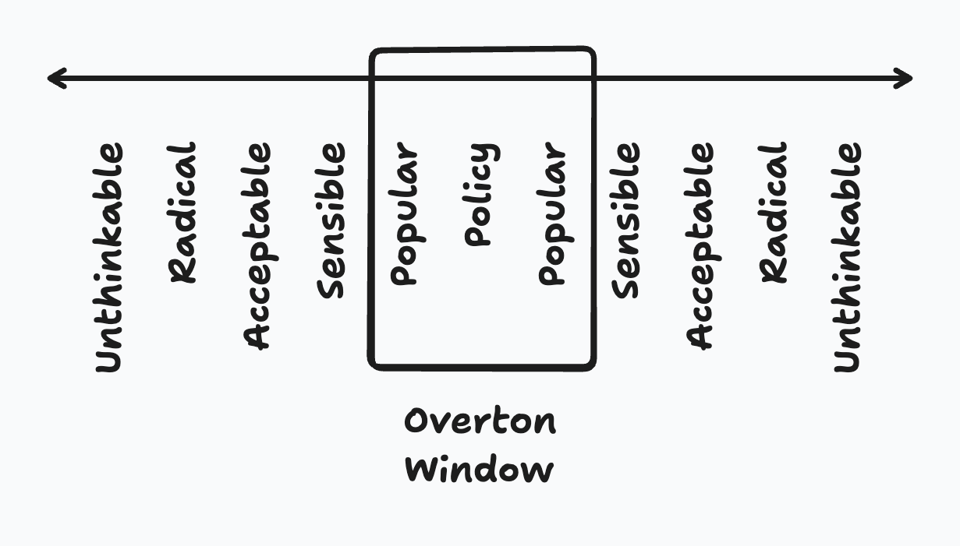Overton Window
Hey!
Welcome back to another week of musings.
We had a long weekend here in the US, and I managed to meet with a friend who came to visit the city.
I hope you had a restorative weekend and are ready for July!
Was this forwarded to you? You can subscribe here!
Things I discovered in the past week
- Taylor Lorenz talks about ChatGPT being a religion now. I wish this were a joke.
- Dead members of Congress can’t stop posting. I hadn't considered this topic in the context of politics, but as I've grown older, the accounts of my relatives come to mind.
I recently came across the concept of the Overton Window, which is particularly relevant to a situation I was experiencing at the time.
The Overton window is the range of subjects and arguments politically acceptable to the mainstream population at a given time.

The concept originates in politics, but it applies to everyone attempting to introduce change within their organization.
Status Quo
In the above picture, the Overton Window illustrates that the center represents "policy", or essentially the status quo of your current context. Depending on the change you want to introduce, you should have an idea of where it falls on the spectrum, from popular to unthinkable.
For example, let's say the status quo is that everything is conducted through ad-hoc meetings, with no agendas or preparation, and a meeting invitation is sent just 5 minutes before the meeting.
It would be unthinkable to implement a policy that requires no meetings unless for a justifiable reason.
Advantageous Usage
Besides helping you understand where the status quo lies and what is acceptable. The other usage is when you want to do things inside the acceptable window, without trying to introduce change itself.
For example, in the status quo, there's a heavy process to create and release applications. You need to submit tickets and document the requirements of your service (memory, CPU), etc. However, nothing is stopping you from submitting all these documents without close oversight, which may result in creating a few new systems and introducing new functionality to the overall infrastructure.
(Use your new knowledge for good!)
Moving the Window
When introducing change, let's assume your organization currently doesn't document anything. So every time someone leaves, for whatever reason, you lose all that context, which has to be learned again.
It would be radical to say that everything needs to go through Architecture Decision Records (ADRs) or High Level Documentation of the changes, etc.
Instead, we should introduce a "popular" change, such as requiring every new project to have a wiki page, or even a more straightforward approach, like requiring every project to have end-to-end (E2E) tests. Over time, people will get used to this new idea so that it would be "sensible" to say: "Let's review the Wiki pages in a Monthly meeting."
And that's how you start moving the window of what's acceptable by your organization! Easier said than done, though, and this will take time, which might not work if your organization has changing leaders, or a new CEO, etc.
Is it my job, though?
If you're not in charge of a team, it might not be your job to change the culture in this manner, especially if it can take years for changes to take effect. However, if you're looking to implement organizational change, it might be best to introduce it by considering what is currently acceptable to the teams.
Your turn!
Have you heard of the Overton Window before? Have you thought of your team's status quo in this way? Or, if this is your first time reading about it, please share your thoughts! Feel free to respond to this email!
Happy coding!